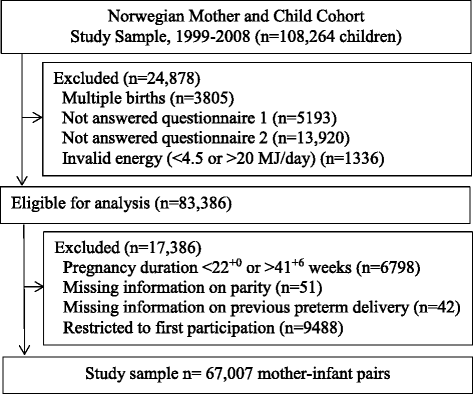Maternal intake of seafood and supplementary long chain n-3 poly-unsaturated fatty acids and preterm delivery
- PMID: 28103845
- PMCID: PMC5248483
- DOI: 10.1186/s12884-017-1225-8
Maternal intake of seafood and supplementary long chain n-3 poly-unsaturated fatty acids and preterm delivery
Erratum in
-
Erratum to: Maternal intake of seafood and supplementary long chain n-3 poly-unsaturated fatty acids and preterm delivery.BMC Pregnancy Childbirth. 2017 Feb 10;17(1):61. doi: 10.1186/s12884-017-1243-6. BMC Pregnancy Childbirth. 2017. PMID: 28187761 Free PMC article. No abstract available.
Abstract
Background: Preterm delivery increases the risk of neonatal morbidity and mortality. Studies suggest that maternal diet may affect the prevalence of preterm delivery. The aim of this study was to assess whether maternal intakes of seafood and marine long chain n-3 polyunsaturated fatty acids (LCn-3PUFA) from supplements were associated with preterm delivery.
Methods: The study population included 67,007 women from the Norwegian Mother and Child Cohort Study. Maternal food and supplement intakes were assessed by a validated self-reported food frequency questionnaire in mid-pregnancy. Information about gestational duration was obtained from the Medical Birth Registry of Norway. We used Cox regression to estimate hazard ratios (HR) with 95% confidence intervals (CI) for associations between total seafood, lean fish, fatty fish, and LCn-3PUFA intakes and preterm delivery. Preterm was defined as any onset of delivery before gestational week 37, and as spontaneous or iatrogenic deliveries and as preterm delivery at early, moderate, and late preterm gestations.
Results: Lean fish constituted 56%, fatty fish 34% and shellfish 10% of seafood intake. Any intake of seafood above no/rare intake (>5 g/d) was associated with lower prevalence of preterm delivery. Adjusted HRs were 0.76 (CI: 0.66, 0.88) for 1-2 servings/week (20-40 g/d), 0.72 (CI: 0.62, 0.83) for 2-3 servings/week (40-60 g/d), and 0.72 (CI: 0.61, 0.85) for ≥3 servings/week (>60 g/d), p-trend <0.001. The association was seen for lean fish (p-trend: 0.005) but not for fatty fish (p-trend: 0.411). The intake of supplementary LCn-3PUFA was associated only with lower prevalence of early preterm delivery (before 32 gestational weeks), while increasing intake of LCn-3PUFA from food was associated with lower prevalence of overall preterm delivery (p-trend: 0.002). Any seafood intake above no/rare was associated with lower prevalence of both spontaneous and iatrogenic preterm delivery, and with lower prevalence of late preterm delivery.
Conclusions: Any intake of seafood above no/rare consumption was associated with lower prevalence of preterm delivery. The association was stronger for lean than for fatty fish. Intake of supplementary LCn-3PUFA was associated only with early preterm delivery. The findings corroborate the current advice to include fish and seafood as part of a balanced diet during pregnancy.
Keywords: Food frequency questionnaire; MoBa; Preterm delivery; Seafood consumption; The Norwegian Mother and Child Cohort Study.
Figures


References
-
- Chang HH, Larson J, Blencowe H, Spong CY, Howson CP, Cairns-Smith S, Lackritz EM, Lee SK, Mason E, Serazin AC, et al. Preventing preterm births: analysis of trends and potential reductions with interventions in 39 countries with very high human development index. Lancet. 2013;381(9862):223–34. doi: 10.1016/S0140-6736(12)61856-X. - DOI - PMC - PubMed
MeSH terms
Substances
Grants and funding
LinkOut - more resources
Full Text Sources
Other Literature Sources
Medical
Miscellaneous

